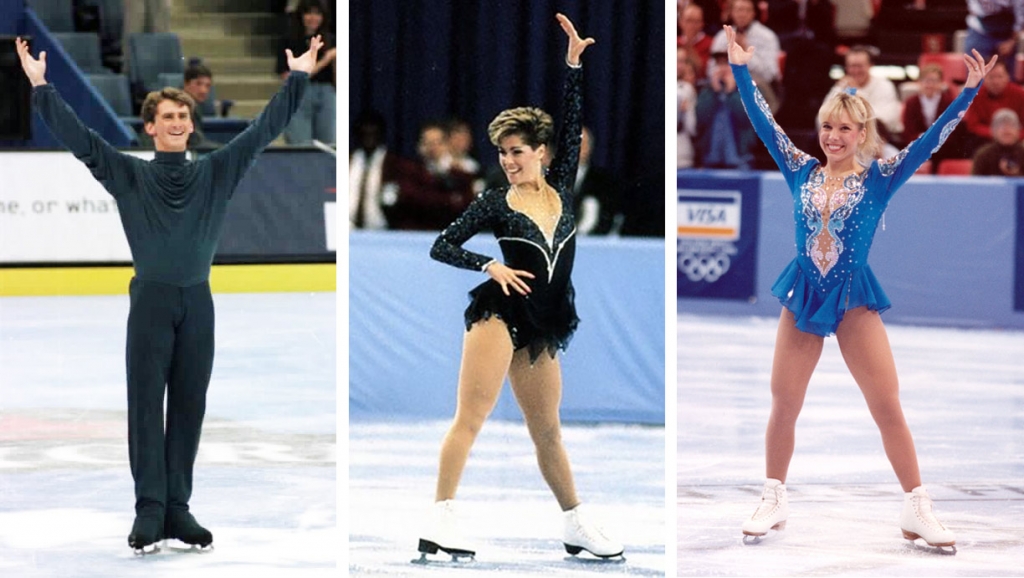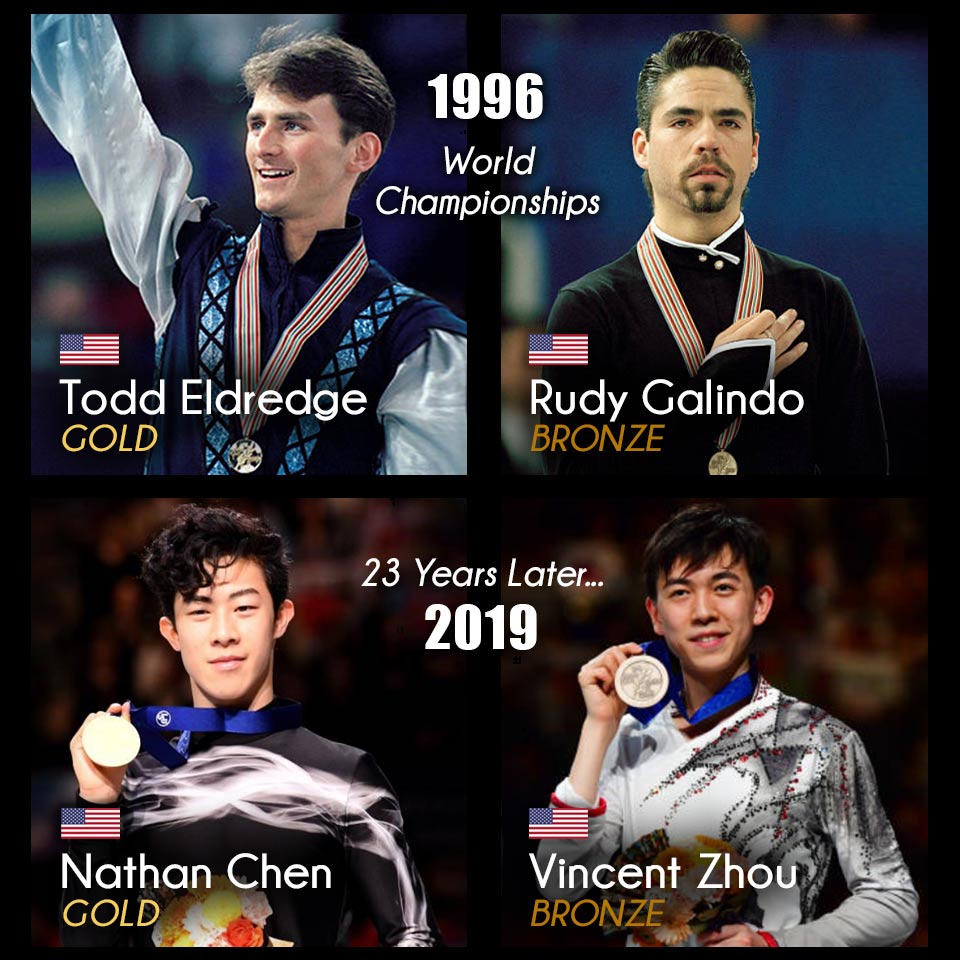Aerial Figure Skating Challenge, Jump Competition 2016
FIGURE SKATERS TO COMPETE FOR $30,000 PRIZE MONEY IN SECOND ANNUAL AERIAL FIGURE SKATING CHALLENGE Olympians Todd Eldredge, Jill Trenary, and Elaine Zayak Judging Competition at 2016 Broadmoor Open COLORADO SPRINGS, Colorado (June, 2016)
In its second year, the Skate Great Aerial Figure Skating Challenge brought jumps — to the Broadmoor World Arena in Colorado Springs on June 24. Wearing practice clothes and skating to pounding rock music in an extreme-sports atmosphere, the athletes brought their best vertical game for the thrill of competition and cash prizes. A total of $30,000 was awarded in various categories.
Aleksei Krasnozhon was a bit of a surprise winner in the men’s event, besting last year’s winner Max Aaron. There was an even bigger surprise in the ladies event, as newcomer Ashley Kim, 13, topped Courtney Hicks for top prize. Kim finished fifth in the novice ladies event at Southwestern Regionals last season.
The format for the event is complicated, but in every round, skaters performed jumps only, without any requirements of choreography or interpretation, showcasing the excitement of the pure athletic side of figure skating to a wider audience. Coaches Tom Zakrajsek and Audrey Weisiger designed the event and hope it will continue to grow.
The event really got underway Thursday night with the Broadmoor Open jumps event, which has taken place for many years. In four events (junior ladies, junior men, senior ladies and senior men), the top three finishers qualified for the Aerial Challenge on Friday. Carly Berrios and Romain Ponsart won the senior events, but since the Aerial Challenge is not yet sanctioned by the International Skating Union, it is only open to U.S. skaters. Ponsart, who is French, wasn’t able to compete. Taylor Morris and Jun-Hong Chen won the junior events.
A panel of judges — including celebrity guest judges Todd Eldredge, Elaine Zayak and Jill Trenary — scored each jump on a scale of 0-10. The numbers roughly corresponded to Grades of Execution (GOE), with 2-8 the equivalent of -3 to +3. A zero meant that a required jump wasn’t attempted. The score was then added to the International Judging System (IJS) base value of the jump. The scores were based on the approach to the jump, the landing speed, air position and appearance of effortlessness, among other criteria.
Hicks was impressive in the first round, turning in with a big double axel, a triple loop with her arms down by her sides and a huge triple flip that scored the first 10 of the event. She went into the second round with 20.88 points. All of the ladies attempted a double axel except Rebecca Peng, who fell hard on an under-rotated triple axel. At the end of the round, Berrios, who included a Rippon triple lutz, was in second with 19.22 points, and Katie McBeath sat in third with 19.04.
Ma won the first round of the men’s event, scoring a total of 29.32 points for a solid triple lutz, a triple axel and a triple flip. He received several 10’s. Krasnozhon was second in the round with 27.22, and Tomoki Hiwatashi was third with 23.14. Aaron popped a quad attempt into a double and sat fourth at the end of the round.
Each skater was allowed one do-over for the entire competition, and strategizing which jump they would re-try proved quite important in the final results. Eight men and eight ladies advanced from the opening round.
Next up was the “combination” round, in which each skater was required to do a three-jump combination that included at least two different triples. Hicks did a triple flip-half loop-triple salchow with good flow and lots of height, receiving 12.10 points to remain in first. Berrios did a triple lutz-single toe-single toe and opted to use her re-do, going on to perform a pretty good triple lutz-triple toe-double toe to stay in second. Kim moved into third with her triple flip-triple toe-triple toe; she also used her mulligan this round and ended up with 14.06 for the segment.
Ma stayed in first by a hair, getting 14.20 for a triple lutz-triple toe-double toe. Krasnozhon scored 15.20 for a triple lutz-double toe-triple loop. Both skaters got into the fun, casual atmosphere of the event by dancing away after they landed their combinations. Aaron needed a do-over for his triple axel-half loop-triple salchow, with a big step-out at the end. He moved up a spot to third with 15 more points.
Five men and five ladies advanced to the next round, in which the ladies were required to do two difficult combinations: a double axel-triple toe and a three jump combination ending in half loop-triple salchow.
Kim moved into first with a good axel combination and a decent triple flip-half loop-triple salchow, totaling 22.86 points for the round. Hicks popped her first axel attempt but had a re-jump available and took it. She stepped out of the axel combination and didn’t have a great landing on her three-jump combination, and her score of 16.28 dropped her to second. Berrios kept her third-place standing by making a strategic choice, opting to do a single toe-half-loop-triple salchow combination (she doesn’t perform a three-jump combination), which was enough to make the championship round.
The men were required to do a triple axel combination, plus a quad of their choice. Both Aaron and Krasnozhon scored well on their triple axel-half loop-triple salchow combinations; Aaron received all 10s for his.
Aaron fell on his quad salchow, Krasnozhon fell on a rotated quad loop and Ma stepped out of the landing of a quad toe. Hiwatashi landed the first quad of the night, a toe, but didn’t make the championship round after putting his hand down on a triple axel-double toe. Aaron notched 25.70 points, while Krasnozhon netted 26.40.
In the championship round, the top three ladies were required to do a triple axel, a jump that Kim and Berrios have have not trained in practice. Berrios did a double axel with a backspin landing, but because she didn’t do the required jump, she received zero points. Hicks has worked on a triple axel and went for it, falling on a downgraded jump. Kim, who said she had never tried the jump before, gave it her best shot and scored a couple of points on a downgraded attempt, landing forward. She hung on for first place with a total of 53.94. Hicks took second with a score of 51.06 and Berrios came in third with 42.42 points.
“I have worked on triple axels before, and they were getting really good,” Hicks said afterward. “I was actually really happy to get the chance to try them in competition. It’s a great competition, because it really makes me work on new elements that I wouldn’t normally work on, and it forces me to push my boundaries.”
“The Aerial Figure Skating Challenge was a very fun and exciting event — different from [other] competitions,” Kim said. “I really enjoyed the experience, being able to skate with such amazing jumpers.”
In a last-minute rule change, the men were required to do two quads back-to-back at different ends of the ice; bonus points would be awarded if they did different quads. Ma skated first and fell on a quad lutz, followed by a fall on a quad toe; he finished in third place with 66.02 points.
Aaron did a quad salchow-double toe combination and included a bit of choreography as he went into a second quad salchow, which he fell on. He added 21.30 points to his score for a total of 84.96, but it was only enough for second place.
Krasnozhon fell on both his quad loop attempts, but he had saved his re-skate and used it. He was required to do both quad loops, and although he fell on the first, it was judged to be rotated. He stood up on the second with a hand down, and the score of 17.00 was enough for a first-place total of 85.82 points.
Each winner received $7,500. Second-place finishers took home $5,000, and third place netted $2,500. The top three also won a free pair of blades from HD Sports. Ma won a bonus prize of $500 for the highest jump of the competition, a triple lutz that Zakrajsek said was 23 inches high and in the air for 0.6925 seconds.
Original article: Link




